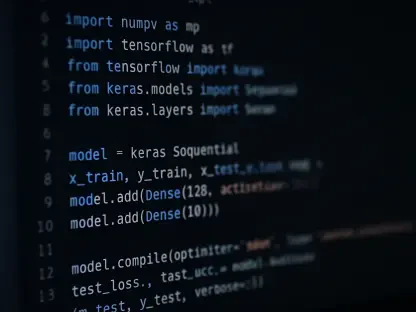As artificial intelligence continues to drive technological advancements across various industries, the importance of mastering programming languages suited for AI development cannot be overstated. Understanding the right tools and languages to use is paramount for anyone looking to have a significant impact in this evolving field. AI programming languages not only differ in their syntax and usability but also in their specialized applications. This can make choosing the right language a daunting task, especially with several options available, each with unique strengths and weaknesses.
Python: The Dominant Force
Python reigns supreme in the realm of AI development and for good reason. Its simplicity and readability make it an excellent choice for both beginners and seasoned developers. Python is famed for its vast library ecosystem, which includes powerhouse libraries like TensorFlow, Keras, and PyTorch. These libraries provide robust frameworks for building and training machine learning models. The vibrant community around Python contributes significantly to its popularity. This community offers a wealth of resources, tutorials, and continuous updates that help developers stay current with the latest AI trends. Python’s versatility extends beyond AI, making it a valuable skill in a developer’s toolkit.
What sets Python apart is not just its ease of use but its adaptability to various AI applications. Whether you are involved in natural language processing, computer vision, or deep learning, Python has the tools and libraries to get the job done efficiently. Its syntax is straightforward, reducing the cognitive load on developers and allowing them to focus more on solving complex AI problems rather than grappling with the language itself. Furthermore, Python’s wide adoption in the industry means that it is often the language of choice for AI research and commercial projects. This broad adoption ensures a rich ecosystem of tools, making development faster and more efficient.
R: The Data Scientist’s Choice
When it comes to data analysis and statistical operations, R stands out. Specifically designed for these purposes, R offers powerful packages such as ggplot2 for visualization and dplyr for data manipulation. These tools are indispensable for data-centric AI applications, particularly in academic research and bioinformatics. R’s strength lies in its ability to handle complex statistical computations and produce high-quality graphics. This makes it a preferred choice among data scientists and statisticians who require precise data analysis capabilities. For those focused on the analytical side of AI, mastering R is immensely beneficial.
R isn’t just about statistical analysis; it also excels in creating reproducible research. The language’s extensive package ecosystem supports a wide range of activities from basic charting to sophisticated multi-layered data visualizations. Academic researchers often rely on R for its rigorous approach to statistical testing and its ability to integrate seamlessly with other data processing tools and languages. Moreover, R provides a platform for developing new statistical methods, thereby extending the landscape of AI research. Its open-source nature and strong user community further bolster its capabilities, ensuring continuous improvement and innovation in data science tools.
Java: Scalability and Reliability
Java is synonymous with scalability and cross-platform capabilities, making it an excellent option for enterprise-level AI applications. Its object-oriented nature and robustness allow developers to build reliable, scalable applications that can run on numerous platforms without modification. Java also boasts a rich set of AI libraries, including Weka, Deeplearning4j, and MOA. These libraries provide comprehensive tools for machine learning and data mining, facilitating the development of complex AI applications. Therefore, Java remains a cornerstone in the tech stack of many large-scale AI projects.
The real strength of Java lies in its mature ecosystem and widespread enterprise adoption. Companies prefer Java for large-scale, mission-critical applications due to its robust performance, security features, and ability to handle significant loads. Java’s strong typing and object-oriented nature make it easier to manage and maintain codebases over long periods. This is especially crucial in enterprise settings where system reliability and uptime are of paramount importance. Furthermore, Java’s platform independence ensures that AI models developed in Java can be deployed across various environments without facing compatibility issues, thus providing a seamless development experience.
C++: Speed and Efficiency
C++ is renowned for its performance and efficiency, which are crucial for AI applications that require real-time processing and resource-intensive computations. This language offers granular control over system resources, making it ideal for high-performance AI tasks. Commonly used in robotics, game development, and computer vision, C++ enables developers to fine-tune performance for specialized applications. Its speed and efficiency make it an invaluable asset for projects needing critical computational power.
C++ allows developers to leverage low-level system operations, ensuring that applications run as fast as the underlying hardware allows. This is essential for AI applications in robotics where real-time decision-making can mean the difference between success and failure. Moreover, the language’s manual memory management capabilities give developers the control needed to optimize resource usage, which is particularly useful in environments with limited computational resources. While C++ may have a steeper learning curve compared to languages like Python or R, its benefits in terms of performance and efficiency make it well worth the investment for specific AI applications.
JavaScript: Powering Web-Based AI
With the growing demand for web-based AI applications, JavaScript has become increasingly relevant. This language allows developers to build accessible AI solutions that run seamlessly in web browsers using libraries like TensorFlow.js. JavaScript’s integration with web technologies ensures that AI functionalities can be easily deployed across various devices without the need for additional software. This makes it an ideal choice for developers aiming to bring AI capabilities to online platforms, enhancing user experience and accessibility.
The versatility of JavaScript extends beyond traditional web development. With the advent of Node.js, JavaScript has also become a powerful language for server-side applications, making it a full-stack solution for web-based AI. The ability to use the same language for both client and server-side coding simplifies the development process and allows for more cohesive and maintainable codebases. Additionally, the rapid development cycles associated with JavaScript frameworks enable quicker iterations and deployments, which is advantageous in the fast-paced world of AI technology.
Scala: The Big Data Specialist
Scala’s combination of object-oriented and functional programming paradigms makes it particularly effective for handling big data. As a key language for Apache Spark, Scala is adept at managing concurrent and parallel processing, rendering it highly efficient for demanding AI tasks. Scala’s proficiency in big data processing ensures that it remains a critical tool for developers working on data-intensive AI applications. Its powerful features and integration with Spark make it indispensable for large-scale data analysis projects.
Scala’s functional programming capabilities allow for concise and expressive code, which is essential for complex data processing tasks. The language’s compatibility with Java further extends its utility, allowing developers to leverage existing Java libraries while taking advantage of Scala’s advanced features. As enterprises increasingly turn to big data solutions for AI, Scala’s importance continues to grow. Its ability to handle large data sets efficiently and perform real-time data processing makes it a cornerstone language for big data platforms, ensuring seamless integration and high performance in AI applications.
Swift: Perfect for Apple Ecosystems
Swift is the go-to language for developing AI-powered applications within the Apple ecosystem. Its optimized performance and modern syntax are well-suited for creating seamless applications on iOS and macOS. The language’s ability to easily integrate machine learning models into mobile applications is vital for developers focusing on AI-driven mobile solutions. Swift’s growing adoption highlights its importance in developing sophisticated AI functionalities for Apple platforms.
One of Swift’s significant advantages is its native performance on Apple devices. This ensures that AI applications run smoothly without the overhead that might come from using non-native languages. Additionally, Swift’s interoperability with Objective-C allows for the integration of legacy code, making it easier for developers to transition to this newer language. The increasing support for machine learning frameworks like Core ML within the Swift ecosystem further enhances its capabilities, making it an ideal choice for developers looking to implement AI functionalities in Apple-specific applications.
Julia: A Rising Star in High-Performance Computing
Julia is rapidly gaining traction in the AI community, particularly for tasks requiring high-performance numerical analysis. It combines the speed of C with the flexibility of dynamic languages, making it immensely powerful for AI research in fields like finance and engineering. Julia’s capabilities in scientific computing make it an attractive option for developers needing substantial numerical computation power. Its performance and ease of use are driving its adoption in various high-stakes AI applications.
The language’s ability to handle heavy computational tasks without sacrificing ease of use makes it particularly appealing for academic and research-oriented AI projects. Julia’s syntax is intuitive for those familiar with other scientific computing languages, reducing the learning curve and accelerating development timelines. Moreover, Julia’s integrated, open-source libraries and package ecosystem foster collaboration and innovation. Its ability to directly call C and Fortran libraries further enhances its utility, making it a versatile tool for a broad range of scientific and engineering applications.
MATLAB: The Academic and Industrial Mainstay
As artificial intelligence continues to drive technological advancements across various industries, mastering programming languages suited for AI development becomes increasingly critical. The significance of understanding the right tools and languages cannot be overstated for anyone aiming to make a meaningful impact in this ever-evolving field.
AI programming languages vary not only in their syntax and usability but also in their specialized applications, which adds a layer of complexity when making a choice. This makes selecting the right language quite daunting, especially with a plethora of options available, each boasting unique strengths and weaknesses.
Languages like Python, known for its user-friendly syntax and extensive libraries, have emerged as popular choices for AI development. However, other languages such as R, Java, and C++ each offer distinct benefits tailored to specific aspects of AI work. Python is ideal for machine learning and deep learning, R excels in statistical analysis, Java is robust for large-scale applications, and C++ offers unparalleled performance optimization.
In summary, understanding AI programming languages is essential, but choosing the best one requires careful consideration of each language’s strengths and the needs of the specific AI project at hand.









